Fishes in the Desert
Traveling around the Sonoran Desert today, especially the northern portion, one would never suspect that it is home to more than 100 species of freshwater fishes. Though there isn’t much free-standing water today, as recently as 100 years ago several of the dry washes were true rivers. The presence of these bodies of water resulted in an incredible array of animals in the region, everything from two inch (5 cm) long topminnows to six foot (1.8 m) long squawfish.
Even today Arizona boasts an impressive 30 or so native species of fish and at least twice as many introduced species. Unfortunately, most of the natives are disappearing with some of them virtually gone. Of Arizona’s native species, at least two-thirds are listed as Threatened or Endangered by state or United States federal agencies. A myriad of factors has resulted in their precarious position, including exotic competitors (and predators), irrigation diversion, dams, and overuse of available water by our burgeoning human population. These factors have led to fragmentation and reduction of habitat available to native species. The status of fishes in Mexico is less certain because there hasn’t been as much study of them. ![]()
Colorado River Fishes
Originating high in the Rocky Mountains, the Colorado River drains seven North American states. The watershed encompasses 242,000 square miles (625,000 km2) before it reaches (on a good day) the Gulf of California, some 10,000 feet (3000 m) lower in elevation. The river has a fascinating history of human use over the last 10,000 years that includes fishing, farming, mining, and even steamboat transport! Today it is of major commercial importance, providing electric power, water for irrigated crops and for 20 million people, of which only around 2.5 million actually live in the river basin.
By the time the river reaches the gulf, the water has been claimed by farmers, power companies, Indian nations, and both the U.S. and Mexican governments. Combined, the capacity of agricultural and municipal diversions actually exceeds the average annual flow of the river through Lee’s Ferry (in northern Arizona).
In the last seven decades, a series of massive dams has been created to regulate the flow of the Colorado River. Since dams create physical barriers to aquatic wildlife and severely alter the characteristics of the river’s flow, natural seasonal changes in flow and water temperature are virtually eliminated. Instead, flow is regulated by electric power demands. Water for power generation is often drawn from the bottom of the reservoir. Waters from the bottom tend to be cold and temperatures are fairly constant. At times, closed dams can shut off all downstream flow.
Many of the introduced fishes evolved in quieter waters, and could be considered “preadapted” for life in reservoirs above dams. Whereas native fishes tend to do poorly or leave areas where great physical and chemical modifications have occurred, many non-natives have flourished. Thus, human modification and stabilization of rivers and construction of reservoirs set the stage for establishment of an exotic fish fauna.
Habitat changes and species introductions have resulted in declining populations or extinction of native Colorado River fishes. The Colorado River today seems more akin to a man-made plumbing system than a wild, naturally flowing river.
The Colorado River basin contains more endemic freshwater fish species than any other river basin in North America. Some are large animals remarkably well-adapted to the swiftly moving waters of the Colorado. Adaptations common to the three so-called big river species listed below are reduced or embedded scales (to reduce friction) and a bizarre hump occurring just behind the head (apparently an adaptation that helps the fish maintain its position in swift currents by pushing it down toward the river bottom).
Representative species:
- bonytail chub
- (Gila elegans)
- (Ptychocheilus lucius)
Stream Fishes of Intermediate Elevations
Many streams and rivers in lower ele-vation coniferous forests, woodlands, and desert grasslands have also been altered. These channels are largely unchanged as they pass through the deep canyons of the headwaters. But, as they reach more gentle terrain and flow through broad valleys, streams have been altered dramatically by human activities. Many streams and their associated riparian areas have disappeared due to irrigation diversion and channelization. The remaining streams, however, still support large populations of native fishes.
Representative species:
- loach minnow
- (Rhinichthys cobitis)
- (Agosia chrysogaster)
- (Gila purpurea)
- (Gila ditaenia)
- (Catostomus clarkii;
also Pantosteus clarkii)
Intermediate- to Low-desert Fishes
Few desert streams remain in Arizona. Most surface water sources have been diverted and subterranean supplies have been cut off by pumping. In most valleys, the water table has been lowered by more than 160 feet (50 m), and in some places, it has been lowered by 1000 feet (300 m)! Some of the fishes occupying intermediate elevations have been forced to migrate upstream by decreasing water tables. Streams below 2000 feet (600 m) in elevation remain only if they receive reliable spring inflows (or sometimes sewage effluent), and many flow only through man-made channels. Other desert streams flow only during times of high precipitation.
Representative species:
- Gila topminnow
- (Poeciliopsis occidentalis)
- (Cyprinodon macularius)
| Basic External Anatomy of a Spiny-rayed Fish |
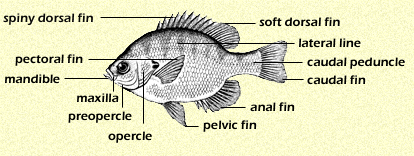 |
bonytail chub (Gila elegans)
Order: Cypriniformes
Family: Cyprinidae (minnows)
Spanish name: charalito elegante
Description
With a streamlined body, terminal mouth, and a thin, pencil-like caudal peduncle, the bonytail chub can grow to over 2 feet (60 cm) long. As with many desert fishes, its coloration tends to be dark above and lighter below. This color pattern may serve to camouflage the fish thereby facilitating prey capture and reducing susceptibility to predation. Breeding males have red fin bases.
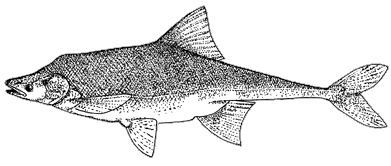
Range
Bonytail chub once occurred in Arizona, Colorado, Utah, Wyoming, New Mexico and California. They have suffered severe reductions in their range and are an Endangered species in the U.S. They persist in the Green River of Utah and maybe in the larger Colorado River impoundments.
Habitat
Bonytail chub have been reported to occupy swiftly moving water but seem to prefer flowing pools and backwaters with rocky or muddy bottoms. Though primarily restricted to rocky canyons today, they historically were abundant in the wide, downstream parts of rivers.
Life History
Adult bonytail chubs feed mainly on terrestrial insects, plant debris, and algae. The young usually eat aquatic insects. Almost nothing is known about reproductive habits. They are presumed to spawn in mid-summer and in some lake situations may hybridize with both humpback and Colorado chubs. ![]()
Colorado River squawfish (Ptychocheilus lucius)
Order: Cypriniformes
Family: Cyprinidae (minnows)
Other Common Names: salmon
Spanish name: charalote
Distinguishing Features
The Colorado River squawfish, growing to 6 feet (180 cm) and over 80 pounds (36 kg) in weight, is the largest minnow in North America. It has a long, conical head with a very large, horizontal, terminal mouth that extends to or beyond the eyes. It tends to have a narrow caudal peduncle and a deeply forked caudal fin. Color above is tan, olive, or brownish, and yellow to whitish below. The sides of the body will often have some scales with a metallic sheen.
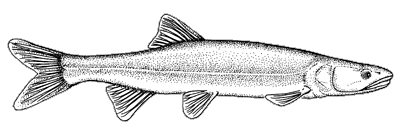
Range
The Colorado River squawfish occurs in Arizona, Colorado, Utah, Wyoming, California, and a few streams in Nevada. The squawfish has been extirpated from the southern part of its range. This fish has suffered severe reductions in its range and is listed as Endangered in the United States.
Habitat
Squawfish are found in swiftly moving water.
Life History
Adult squawfish feed on other fish and smaller birds or mammals that light on or fall into the water. The young feed on aquatic insects and crustaceans.
Squawfish spawn in river channels over gravel beds. Apparently they reproduce in late spring to mid summer when water temperatures exceed 21° C (70° F) and water levels drop. Below dams these necessary temperature and water fluctuations usually don’t occur. Water released from dams is cold and constant in temperature and the amount of flow seldom drops at the right time to stimulate spawning. At times, no water is released below dams. These conditions severely restrict where fish can survive. Though now virtually extinct in Arizona, historically these fish were so common that they were removed from irrigation canals and ditches with pitchforks and used to fertilize crops.
Recovery Efforts
Efforts to recover the Colorado squawfish, bonytail chub, razorback sucker, and other native fishes have been largely unsuccessful in Arizona. Federal and state agencies and private organizations produce millions of fingerlings (juvenile fish about as long as a person’s finger) that are released into previously and currently occupied habitats. However, habitats have been severely modified and exotic species often prey upon these small, juvenile fish. Currently, native species that are to be released in the wild are being raised to larger sizes before being released. It is hoped that larger size will discourage predation by exotics. Additionally, in some locations, flow regimes below dams have been modified in recent years to provide more of the natural cues necessary to stimulate spawning by these species. Fish ladders have been installed in some locations to help migrating fish pass around dams and other obstructions. It will take years before the success or failure of these efforts can be assessed. ![]()
That’s a Mouthful!
I was down at the Desert Museum’s beaver pond exhibit one spring morning feeding crickets to squawfish. As I tossed the crickets towards these 3H foot (1 m) long fishes, they’d breach the surface and snatch the tiny morsels in their huge mouths.
Some Mallards, realizing there was free food to be had, watched nearby. One of them finally swooped in to nab a cricket. Unfortunately, a squawfish, with its eye on the same cricket, broke the surface and grabbed the duck’s head in its mouth. The water exploded with beating wings and flailing fins as both startled parties fled in opposite directions. I let a few minutes pass and then threw some more crickets into the pond. The squawfish eyed them suspiciously, peering up out of the water for signs of dangerous ducks before gingerly taking the insects.
This incident really demonstrated to me that fish are very much in tune with their surroundings. And that they can be quick learners!
—Ken Wintin, Desert Museum keeperrazorback sucker (Xyrauchen texanus)
Order: Cypriniformes
Family: Catostomidae (suckers)
Other Common Names: buffalofish, buffalo
Spanish name: matalote jorobado
Distinguishing Features
The razorback sucker is our largest native sucker, perhaps reaching 36 inches (91 cm) in length and 11 pounds (5 kg) in weight. Adults have subterminal mouths with large fleshy lips and sharp, blade-like keels running down their backs. This keel extends from behind the head to the dorsal fin. The young of this species are virtually indistinguishable from those of other suckers. Colors vary from olive to light brown laterally and yellow or white below.
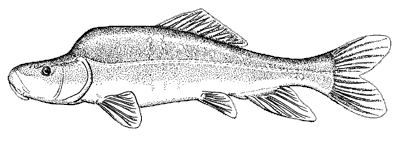
Range
The razorback sucker is a fish of the Colorado River drainage, occuring in Arizona, Colorado, Utah, Wyoming, California, and a few streams in Nevada. It is currently found only north of the Grand Canyon, except for relict populations in Lake Mead, Mohave, and Havasu. This fish has suffered severe reductions in its range and is listed by U.S. agencies as Endangered.
Habitat
Razorback suckers seem to prefer flowing pools and backwaters. They are most often found in sandy areas and undercut banks. Historically they were reported to occupy areas with strong, uniform currents.
Life History
Razorback suckers feed primarily on algae and fly larvae, as well as planktonic crustaceans. Spawning has been observed in some human-made impoundments. Generally, a group of 2 to 12 male suckers attend to one female, the males nudging the female’s genital region with their heads and the front part of their keels. As the female settles to the bottom, she is flanked by at least one male on each side. Vibrations ensue and end with strong convulsions; many males then fertilize the eggs.
Comments
Several agencies have been involved in a recovery effort for this species. Millions of larvae and juvenile fish have been stocked in current and former habitat, but there is little evidence of recovery. ![]()
loach minnow (Rhinichthys cobitis)
Order: Cypriniformes
Family: Cyprinidae (minnows)
Spanish name: charalito adornado
Distinguishing Features
This is a small minnow usually less than 2H inches (6.3 cm) long. The eyes are situated somewhat dorsally. The species is typically olive-brown with black specks and blotches dor-sally, and a black spot in the middle of a white bar at the base of the caudal fin. Breeding males develop brilliant orange to blood-red patches on the lips, fins (bases mainly), and sometimes on the body. Females are fairly drab but can develop yellow coloration on the fins and body.
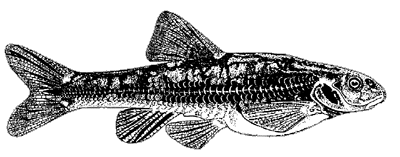
Range
This minnow is found mainly in the Upper Gila River system of New Mexico and Arizona and in the San Pedro River of Arizona and northern Sonora. It is uncommon in Arizona but locally abundant in New Mexico. It is protected in the U.S. as a Threatened species.
Habitat
Loach minnows live in shallow riffles, usually less than 6 inches (15 cm) deep. Generally the substrate in these riffles is coarse gravel. Loach minnows tend to be secretive bottom dwellers most commonly associated with beds of filamentous algae.
Life History
The loach minnow feeds almost
entirely on mayfly and blackfly larvae. It spawns from March through September. Males may be territorial and defend nests, which are placed downstream of stones in riffles.
This species has a greatly reduced air bladder, which means swimming above the streambed is energetically expensive. Therefore, it spends its life on the bottom. In many respects the ecology of the loach minnow resembles that of darters. Loach minnows live only 2
or 3 years. ![]()
longfin dace (Agosia chrysogaster; formerly Rhinichthys chrysogaster)
Order: Cypriniformes
Family: Cyprinidae (minnows)
Spanish name: charalito aleta larga
Distinguishing Features
Longfin dace can be up to 4 inches (10 cm) long; it has a rounded snout and a slightly subterminal mouth with a small barbel at each corner. Coloration is dark gray above with a dark band along silver sides and creamy white or light yellow below. There is a black spot at the base of the caudal fin. In adult males paired fins are yellow at their bases while large females have an elongated lower lobe of the anal fin. In breeding condition males develop nuptial tubercles on the fins and head which superficially resemble the common disease of aquarium fish known as “ich.”
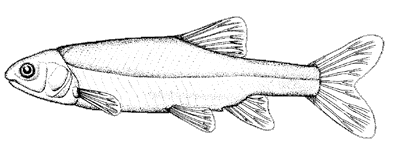
Range
Longfin dace are our most common native fish and have the widest distribution of any species in the region. This species is found primarily in the Gila and Bill Williams river systems (Colorado River drainage) of Arizona and New Mexico. It is also common in the Pacific drainages of western Mexico. This fish is most commonly found at intermediate elevations, occurring from the Arizona Uplands to low-desert streams.
Habitat
Longfin dace are found in relatively shallow, sandy, gravelly, to rocky streams. They are frequently found in flowing pools. This species can survive in a dry stream by living in moist algal mats. In these mats they encounter high temperatures, extreme temperature fluctuations, and low dissolved oxygen—conditions that would kill most other fish. Young longfin dace are known to be active when water temperature is as high as 33° C (92° F).
Life History
An omnivore, the longfin dace feeds
on whatever is available. It spawns throughout the year over relatively soft, sandy bottoms. Eggs are laid in nest pits and hatch in a few days. After hatching the young tend to select slower moving waters along the edge of the stream, whereas juveniles and adults move into the smooth runs of the main channel. ![]()
Yaqui chub (Gila purpurea)
Order: Cypriniformes
Family: Cyprinidae (minnows)
Spanish name: charalito Yaqui
Distinguishing Features
Yaqui chubs can be up to 5H inches (14 cm) long. Body color varies from steel blue to yellow-brown. The base of the caudal fin has a triangular black wedge, and the anal fin has 7 rays. Males turn blue-gray when they are in breeding condition.
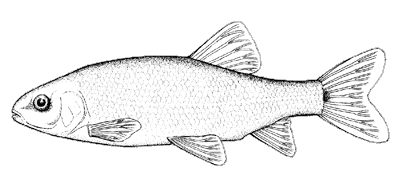
Range
The Yaqui chub is found principally in Sonora, Mexico in the Yaqui, Sonora and Matape rivers. This Endangered Species naturally enters the United States only in San Bernardino Creek, but it has been introduced into Leslie Creek in southeast Arizona.
Habitat
Prefers quiet pools of headwaters, creeks, and marshes.
Life History
The Yaqui chub is omnivorous, feeding on algae, terrestrial and aquatic insects, and arachnids. It generally reproduces from spring to early summer.
Comment
The Yaqui chub is listed as Endangered by the U.S. Fish and Wildlife Service. Apparently all naturally occurring populations in Arizona were lost because the waters in which they occurred dried up. Prior to the loss of the last natural
population in Arizona, individuals were translocated into Leslie Creek at the south end of the Swisshelm Mountains, where they still persist.![]()
Where Have All the Natives Gone?
Today in Arizona there are three times as many species of introduced or non-native
fishes as there are native species. The reasons for this are numerous and complicated. Man’s increased demands for water to provide electrical power have resulted in the drying up of some waterways, as well as in the creation of man-made dams and channels that inevitably alter the habitat of native species of all kinds. Those species whose specific requirements
cannot be met in this altered environment face the probability of extinction within that area. In addition, large numbers of non-native fishes have been introduced in Arizona streams
and lakes for game purposes. The native species are often preyed upon or outcompeted for
food and territory by introduced species. Loss or alteration of habitat is equally detrimental to often highly adapted native fishes. ![]()
Sonora chub (Gila ditaenia)
Order: Cypriniformes
Family: Cyprinidae (minnows)
Spanish name: charalito sonorense
Description
In the United States, the Sonora chub is generally smaller than 8 inches (20 cm), but in Mexico it may grow up to 10 inches (25 cm) long. The Sonora chub has a somewhat chubby body. The upper half of the body is generally dark with two black lateral bands above and below the lateral line; the lower half of the body is much lighter. When fish are in breeding condition the bases of the anal and paired fins are red, and part of the belly may be orange.
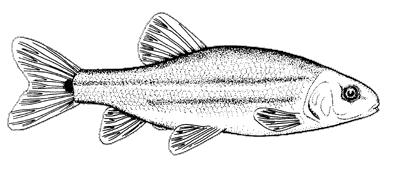
Range
The Sonora chub is only found in the Rio de la Concepción drainage of northern Mexico. Sycamore Creek, near Nogales, forms the headwaters of this drainage and is the only place in Arizona where you can find this fish.
Habitat
This fish tends to inhabit shaded pools with undercut banks which, during droughts, may be the only areas where water is present. Even in times of high stream flow, chubs seem to stay in these same pools.
Life History
Sonora chubs are omnivorous, feeding on aquatic and terrestrial insects and algae. They spawn in early spring. These remarkable fish are capable of surviving in small habitats under extremely difficult environmental conditions. At times this species persists in wet algal mats with almost no free water. ![]()
desert sucker (Catostomus clarkii; also called Pantosteus clarkii)
Order: Cypriniformes
Family: Catostomidae (suckers)
Spanish name: matalote del desierto
Distinguishing Features
The desert sucker grows to 13 inches (33 cm). Its color varies from green to silver or tan above and silver to yellow below. During the spawning season breeding males develop a striped pattern consisting of 1 or 2 light lateral stripes on a darker background. This sucker has a subterminal mouth with enlarged cartilaginous lobes behind the lower lip. The front of the upper lip lacks papillae (small, flap-like growths).
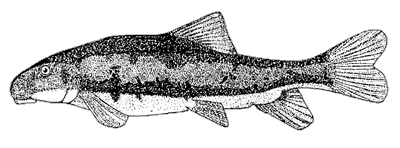
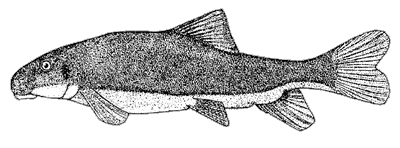
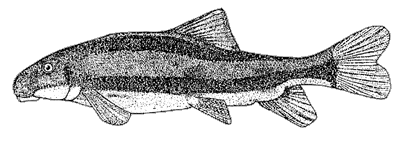
Pattern variations in the desert sucker
Range
This common fish of the Lower Colorado River drainage downstream of the Grand Canyon also lives in the Virgin River of Utah, Arizona, and Nevada, the Bill Williams River of Arizona, and the Gila River drainage of New Mexico, Arizona, and northern Sonora, Mexico.
Habitat
The desert sucker occupies small and medium rivers. Young fish occupy backwaters, while adults are found in pools with undercut banks during the day and riffles at night.
Life History
While the desert sucker is omnivorous, it prefers diatoms and algae that cover rocks. It uses the cartilaginous sheaths on the jaws to scrape these food items from the rocks. Spawning occurs in the spring over riffles and generally involves 1 female and 2 or more males. The female creates a depression in the gravel with lateral movements of her body. She then deposits eggs which are fertilized by the males. The eggs are buried in the loose gravels, and hatch in a few days. ![]()
Yaqui catfish (Ictalurus pricei)
Order: Siluriformes
Family: Ictaluridae (catfishes)
Spanish name: bagre del Yaqui
Distinguishing Features
Yaqui catfish reach almost 2 feet (60 cm) in length. Externally they are similar to the channel catfish (Ictalurus punctatus) though they have shorter pectoral spines. This species has 4 pairs of barbels (whiskers) along the side and the rear of the mouth. It has an adipose (soft, rayless) fin and spines in the dorsal and pectoral fin origins and in the pectoral fins. Coloration is silver-tan to goldish above, transitioning to silver or silver-white below.
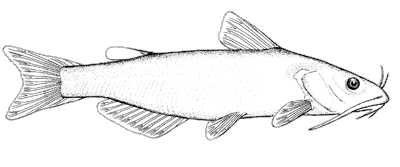
Range
This is a fish of the Río Yaqui and Río Casas Grandes drainages of northwestern Mexico and extreme southeastern Arizona. It is found mainly in small or medium rivers from intermediate to lower elevations. A rare fish in Arizona due to limited range, it is protected in the United States as a Threatened Species. It is still relatively common and unprotected in Mexico.
Habitat
The Yaqui catfish prefers quiet water over sand-rock substrates.
Life History
Almost no information is available
on this species, but its life history is presumed to be similar to that of the channel catfish. Catfish tend to be nocturnal and feed upon aquatic invertebrates while young. When they reach 4 inches (10 cm) in length they begin to also feed on algae and small to medium sized fishes. They spawn from April through early June. An egg mass is laid in a protected depression in the substrate. Eggs are generally guarded by the male. While guarding eggs, males are quite aggressive and bite readily. Though there are at least 7 species of catfish in Arizona, the Yaqui catfish is the only one native to the state. ![]()
Gila topminnow (Poeciliopsis occidentalis)
Order: Cypriniformes
Family: Poeciliidae (live-bearers)
Spanish name: charalito
Distinguishing Features
This is a very small fish measuring only 2G inches (5.7 cm). Males are smaller than females and have a very long gonopodium (over N of the body length), which is an anal fin modified into a sexual organ for internal fertilization. Color is light olive-tan to silver with a small black spot at the back of the dorsal fin. Large males are black with an orange gonopodium base. Males have slender bodies with small eyes.
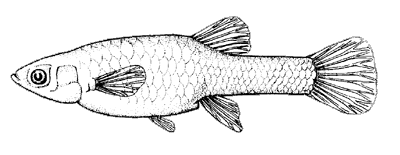
Range
Gila topminnows were once found in the Gila River basin of Arizona, New Mexico, and northern Mexico from intermediate to lower elevations. At one time Gila topminnows were among the most common fishes in the low desert of the United States; they are now endangered. They are rare in Arizona and have been extirpated from New Mexico.
Habitat
This species prefers shallow, warm, slow-moving waters of creeks and small or medium rivers.
Life History
Gila topminnows feed upon vegetation and amphipod crustaceans as well as aquatic insect larvae. They breed mostly from January to August, though some pregnant females may be found throughout the year. Topminnows have internal fertilization and are live-bearers; they are the only native fish in Arizona to bear live young. Broods range from 1 to 15. Usually females are carrying 2 broods simultaneously, one more developed than the other.
Comments
This fish was once very common; it is also very prolific. The Desert Museum obtained 85 Gila topminnows for breeding and in less than one year this number had swelled to 3000. Given these reproductive capabilities it is hard to believe that this species has almost completely disappeared. The main cause of its disappearance is predation by a close relative, the mosquitofish (Gambusia affinis), which was introduced from the Mississippi River basin for mosquito control. Mosquitofish primarily eat young topminnows and may compete with them for critical resources. Mosquitofish have been known to replace a population of topminnows
in one season. ![]()
desert pupfish (Cyprinodon macularius)
Order: Cypriniformes
Family: Cyprinodontidae (pupfishes)
Spanish name: cachorrito del desierto
Distinguishing Features
Males reach a length of almost 3 inches (76 mm); females are two-thirds that length. Breeding males become a beautiful, iridescent blue, while females, young, and non-breeding males tend to be drab whitish-tan with dark vertical bars (parr marks). Breeding males develop lemon- yellow or orange caudal peduncles and fins.
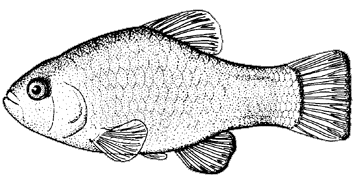
Range
Originally this species was found in the Lower Colorado River drainage in Arizona, California, and northern Mexico. Now this endangered species is restricted to a few parts of its former range.
Habitat
Considered a fish of desert oases, this species of pupfish is found in springs, marshes, lakes, and creek pools. It prefers sandy substrates.
Life History
Pupfish are omnivorous, feeding on aquatic invertebrates and plants. Breeding occurs mainly in the spring and the summer. Breeding males are fiercely territorial, defending their turf against invasion by other males. Females that are ready to spawn will enter the male’s territory. After spawning the male guards the nest. Periodically a subordinate male may sneak into his territory while the dominant male is busy chasing away other fish. The subordinate may spawn with the female and then retreat to a safe place. The dominant male may therefore inadvertently wind up protecting eggs fertilized by another male.
This species is remarkably adaptable to rapid changes in temperature and salinity. It has been known to survive in fresh as well as salty water (with greater salinity than sea water) and to endure water temperatures over 100°F (38°C) or below 50°F (10°C).
Pupfish are endangered due to habitat destruction and fragmentation. They have been, and continue to be, preyed upon and displaced by non-native fishes. ![]()
Sinaloan cichlid (Herichthys beani; also Cichlasoma beani, Heros beani)
Order: Perciformes
Family: Cichlidae (cichlids)
Other common name: green guapote
Spanish names: mojarra sinaloense, mojarra verde
Distinguishing Features
The Sinaloan cichlid is a large fish, up to 10 or more inches (25 cm) long. The species is similar in form to sunfish, with co-joined spiny and soft portions of the dorsal fins. Coloration varies depending upon breeding condition. Non-breeding animals are usually a mixture of subdued yellow and black. Breeding females are much smaller than males and develop striking yellow tops and upper sides with jet black lower sides and belly. Breeding males generally have yellow scales with black spots in the centers of the scales.
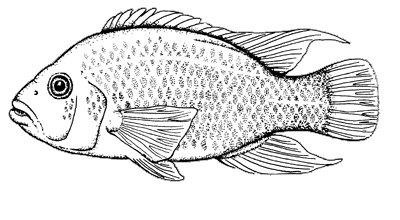
Range
Native to the Río Yaqui basin, mainly along the western side of northern Mexico, these cichlids have a tropical distribution, with the lower Río Yaqui being their northern limit.
Habitat
The Sinaloan cichlid tends to prefer quieter waters of medium to large rivers, generally in rocky or gravelly areas.
Life History
This cichlid is an omnivore that feeds on detritus, aquatic vegetation, invertebrates, and other fishes. It is capable of spawning throughout the year. Breeding pairs aggressively defend the adhesive eggs, which are laid on medium sized rocks. They also defend the young. One parent remains with the young until they are able to fend for themselves.
Comments
In spite of an extremely pugnacious nature, this species may be declining from competition with and predation by introduced species such as other cichlids and sunfishes. ![]()
Additional Readings
Minchley, W. L. Fishes of Arizona. Phoenix: Arizona Game & Fish Department, 1973.
Page, Lawrence M. and Brooks M. Burr. A Field Guide to Freshwater Fishes: North America North of Mexico. Boston: Houghton Mifflin, 1991.
Rinne, John N. and W. L. Minckley. Native Fishes of Arid Lands: A Dwindling Resource of the Desert
Southwest. Ft. Collins, CO: USDA Forest Service General Technical Report RM-206, 1991. ![]()







